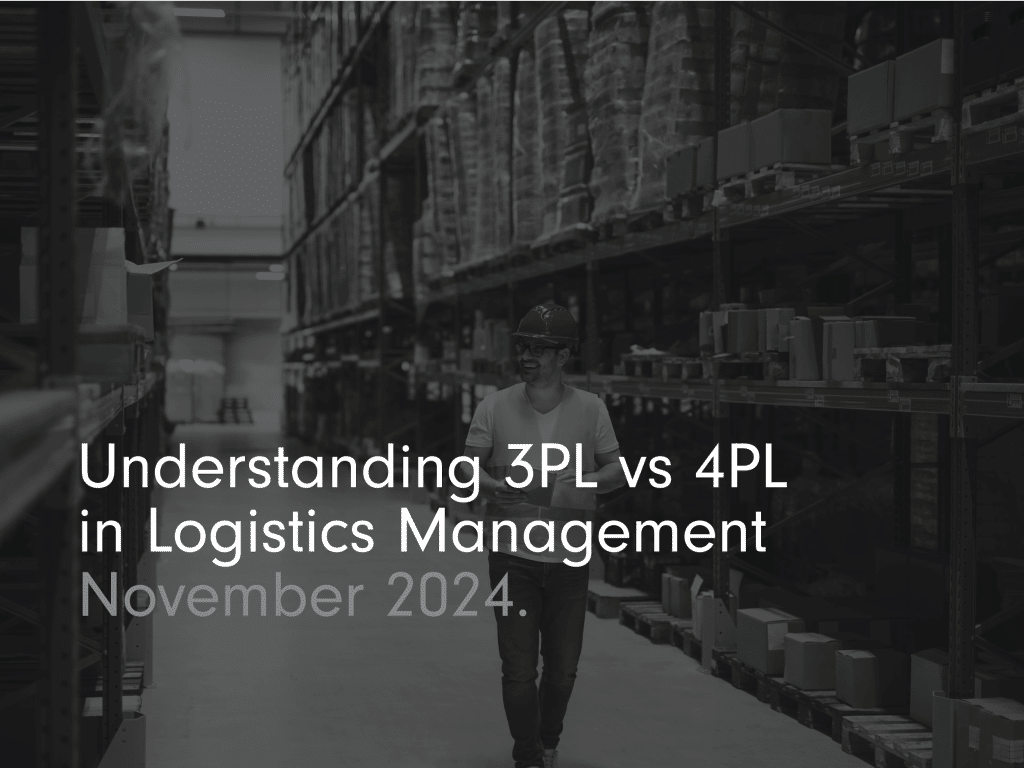Understanding 3PL vs 4PL in Logistics Management

Effective logistics management nsures that products reach customers efficiently and cost-effectively. Here, we explore the differences between two common logistics models: third-party logistics (3PL) and fourth-party logistics (4PL). Businesses use these models to streamline their supply chain operations.
Introduction.
Logistics is the backbone of any business, involving the management of goods from the origin to the final destination. Choosing the right logistics model can significantly impact your efficiency and bottom line.
The logistics landscape includes various provider levels with each option offering different levels of supply chain control. This allows organizations to find solutions that match their needs and goals. Let’s explore 1PL vs 2PL vs 3PL vs 4pl vs 5pl.
1PL (First-Party Logistics): This is when companies manage their own logistics operations. They deliver products directly to customers using their own vehicles.
2PL (Second-Party Logistics): A logistic service where a company hires an outside carrier or transport service to move goods.
3PL (Third-Party Logistics): A 3PL company provides logistics services like warehousing, transportation, and order fulfillment. They act as an outsourced logistics partner for businesses.
4PL (Fourth-Party Logistics): A 4PL company is responsible for managing the entire supply chain. They oversee 3PL providers and ensure that all logistics operations run smoothly for the client.
5PL (Fifth-Party Logistics): This is an advanced logistics model. The provider manages supply chain and logistics for multiple clients. They use advanced technology and solutions to do this.

Understanding 3PL.
What is a 3PL Company?
A 3PL company provides logistics services to businesses, allowing them to outsource specific logistics operations such as warehousing, transportation, and inventory management.
Key Services Provided by 3PLs
- Transport and Freight Management: Handling the transportation of goods between locations.
- Warehousing and Inventory Management: Storage solutions and inventory tracking.
- Order Fulfilment: Processing and shipping customer orders.
- Reverse Logistics: Managing returns and exchanges.
Benefits of Using a 3PL
- Cost Efficiency: By outsourcing logistics operations, businesses can save on the costs associated with managing their own logistics.
- Expertise and Resources: 3PLs have the skills and resources to manage logistics efficiently. This reduces the chance of delays or errors.
- Flexibility: Businesses can scale their logistics operations up or down based on demand.

Exploring 4PL.
What is a 4PL Company?
A 4PL company manages all aspects of a client’s supply chain, including overseeing 3PL providers. They act as a strategic partner, ensuring seamless logistics operations.
How 4PLs Differ from 3PLs
Unlike 3PLs, which focus on specific logistics tasks, 4PLs provide a comprehensive logistics solution, managing the entire supply chain. They coordinate with multiple suppliers and service providers to optimise logistics processes.
Benefits and Challenges of Employing a 4PL
- Benefits: Greater efficiency, strategic planning, and a holistic approach to supply chain management.
- Challenges: Higher operational costs and the need for robust communication and coordination.
Key Differences and Similarities
While both 3PL and 4PL provide essential logistics services, there are some critical differences and similarities to consider.
Similarities: Both 3PL and 4PL provide logistics services that help businesses manage their supply chains effectively. They both aim to enhance supply chain operations and deliver products to customers efficiently.
Differences: The primary difference lies in the level of control and oversight. A 3PL manages specific logistics tasks. A 4PL serves as a single point of contact. It oversees the entire supply chain and coordinates with various service providers.

3PL vs 4PL: A Comparative Analysis.
Cost Analysis
- 3PL: Generally, 3PL services are more cost-effective for businesses needing specific logistics services occasionally. This option helps companies save money. They only pay for the services they need at any given time. It’s ideal for those with limited budgets or changing logistics demands.
- 4PL: 4PL provides great value by managing the entire supply chain. However, it usually costs more upfront because of its strategic oversight. Businesses choosing 4PL invest in a complete management solution. This can optimize the supply chain and may lead to cost savings over time.
Flexibility Considerations
- 3PL: Offers great flexibility, letting businesses pick and use specific services based on their needs. This flexibility is helpful for companies with frequent demand changes or those needing customized logistics for different projects.
- 4PL: Offers less daily flexibility but provides long-term strategic benefits by optimizing the whole logistics model. This approach is great for businesses looking to simplify operations and increase efficiency in the supply chain. It might require sacrificing some short-term flexibility, but the benefits can be worth it.
Customisation Capabilities
- 3PL: Services can be customized to meet specific logistics needs. These include transportation, warehousing, or distribution. Businesses can choose the exact services they need. This allows for a tailored logistics solution that aligns with their goals.
- 4PL: Customization covers the whole supply chain. It allows integration with different logistics operations and providers. This lets businesses build a smooth logistics network. It can adapt to complex needs and changing market conditions.

Technological Integration
- 3PL: Uses technology to improve logistics processes like inventory management or shipping. By focusing technology on specific areas, 3PLs can boost efficiency and accuracy in their services.
- 4PL: Uses advanced technology to manage and improve the entire supply chain. It combines data from many sources. This smart use of technology helps see everything in real-time and make quick decisions. These improvements benefit the whole supply chain.
Growth Potential
- 3PL:Provides scalable solutions for logistics tasks, perfect for businesses looking to expand specific services as they grow. This method helps companies adjust their logistics operations to meet rising demand or seize new market opportunities.
- 4PL: Offers enterprise-level flexibility. It manages the entire supply chain, including handling growth in various regions and markets. This overall flexibility ensures businesses can keep logistics operations efficient and effective as they expand globally.
Strategic Planning and Oversight
- 3PL: Takes a tactical approach that focuses on logistics execution. Provides services to support daily operations. This focus on execution makes 3PL a good choice for businesses with immediate and specific logistics needs.
- 4PL: Focuses on strategic planning and manages logistics and supply chains as a whole. Drives continuous improvement. By overseeing strategy, 4PLs help businesses reach long-term goals. They streamline operations and encourage innovation in the supply chain.

Factors to Consider When Choosing Between 3PL and 4PL.
When deciding between 3PL and 4PL, consider the following factors:
- Business Size and Needs: Smaller businesses might find 3PL services more beneficial. Larger companies with complex supply chains may need a 4PL for a more comprehensive approach.
- Budget: Consider your budget constraints and the cost-effectiveness of each option.
- Control and Oversight: Decide how much control and oversight you want over your logistics operations.
- Long-term Goals: Align your choice with your company’s long-term strategic objectives.
Conclusion.
In summary, while both 3PL and 4PL provide valuable supply chain solutions, they cater to different levels of business needs. 3PLs offer specific logistical support, while 4PLs manage the entire supply chain, acting as a single point of contact. Choosing the right logistics model is crucial for enhancing supply chain management and delivering products to customers efficiently.
For more insights into logistics operations and solutions for your business, reach out to our experts. They will help you find the right logistics model to boost your business’s success.
Frequently Asked Questions.
The main difference lies in the scope of services. 3PL handles specific logistics tasks, while 4PL manages the entire supply chain, including coordination with 3PL providers.
Yes, 4PL services are usually better for large businesses with complex supply chains. But smaller businesses can still gain from a 4PL’s strategic oversight. This is true if their operations make the investment worthwhile.
4PL services often come with higher costs due to their comprehensive nature. However, the strategic benefits and efficiency gains can outweigh these costs in the long run.